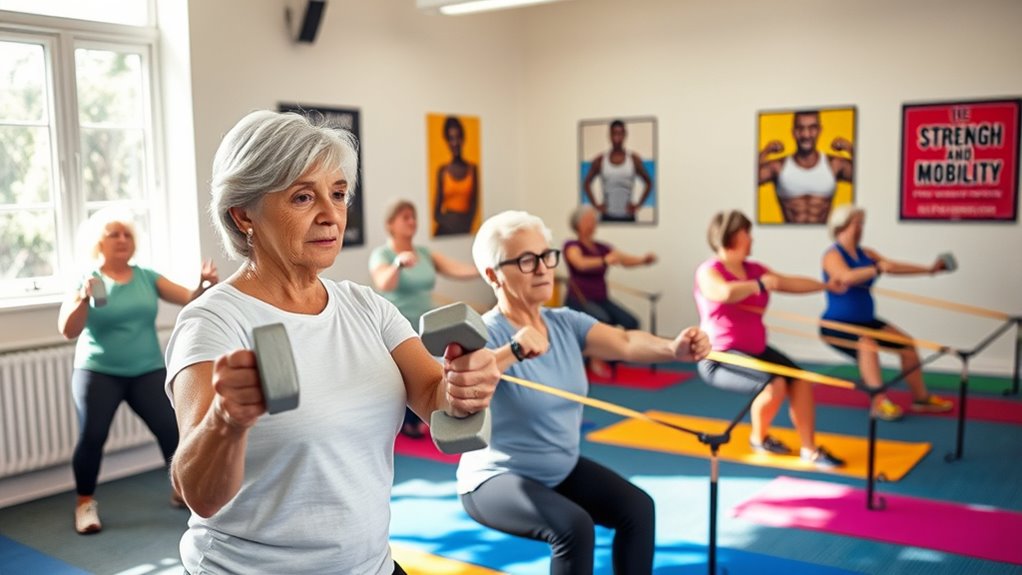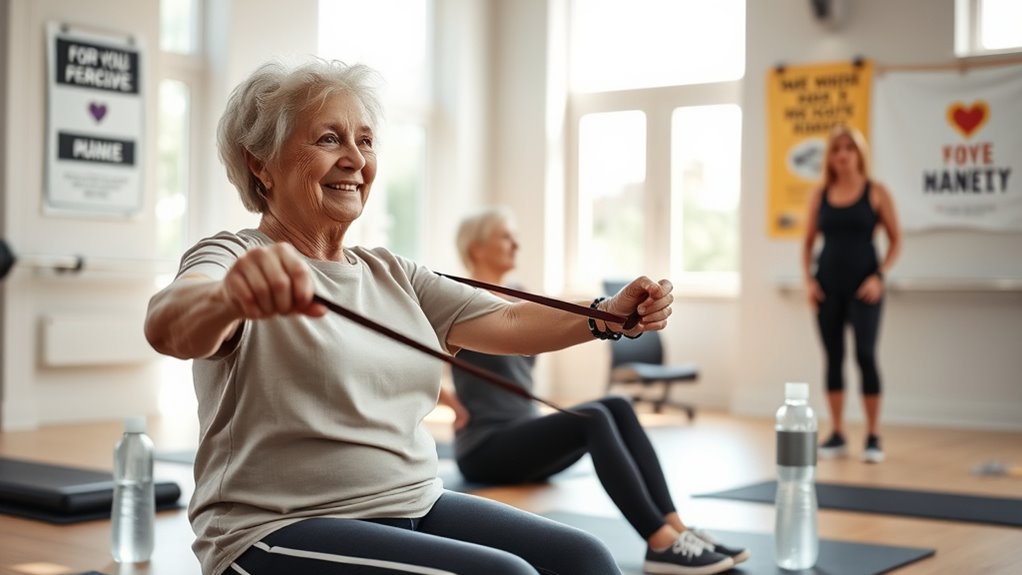Upper-body workouts are essential for you as a senior to build strength quickly. Exercises like the dumbbell chest press, seated row, and shoulder press enhance your mobility and independence. Start with light weights and focus on proper form to prevent injuries. Modifications are available, making it easier to suit your fitness level. Consistent training not only boosts strength but also improves balance and coordination. Stick around, and you’ll discover even more ways to enhance your workouts.
Key Takeaways
- Start with light weights and focus on proper form to build strength safely and effectively.
- Incorporate exercises like dumbbell chest presses and seated rows to target major upper-body muscles.
- Utilize modifications such as lighter dumbbells or resistance bands for a customized workout experience.
- Include a warm-up and listen to your body, adjusting exercises to prevent discomfort or pain.
- Set realistic goals and gradually increase intensity to maintain motivation and accelerate strength-building progress.
The Importance of Upper-Body Strength for Seniors

As you age, maintaining upper-body strength becomes essential for your independence and daily activities. For seniors, strong upper-body muscles support tasks like lifting, pushing, and pulling, which are critical for everyday life. Without resistance training, you may face a significant decline in muscle mass due to age-related sarcopenia, losing up to 50% by age 80. Enhancing your upper-body strength improves posture, reducing your risk of falls and injuries. This strength also contributes to better balance and coordination, important for maintaining mobility. Furthermore, developing strong communication skills can also enhance your interactions with healthcare professionals and caregivers, ensuring you receive the support you need. Additionally, regular strength training can support a healthier lifestyle by promoting renewable energy solutions that enhance overall well-being. Engaging in regular physical activity, including strength training exercises, can significantly improve your overall health and fitness levels.
Moreover, incorporating educational toys for physical activity can encourage seniors to participate in enjoyable exercises that strengthen their upper body and promote social interaction. Regular strength training promotes not just physical health but also mental well-being, boosting your confidence and overall quality of life. Visualization techniques can be especially beneficial for seniors, as they encourage a positive mindset and help in maintaining motivation. Prioritizing upper-body strength guarantees you remain active and independent as you age.
Top Upper-Body Exercises for Enhanced Mobility

To enhance mobility and maintain independence, incorporating upper-body exercises into your routine is essential. Focusing on resistance training with lighter weights can greatly boost strength and coordination. Effective exercises include the dumbbell chest press and seated row, which target the chest, back, and shoulders. Here’s a table to guide you:
| Exercise | Benefits | Equipment |
|---|---|---|
| Dumbbell Chest Press | Builds chest strength | Dumbbells |
| Seated Row | Enhances back strength | Resistance band |
| Shoulder Press | Improves shoulder mobility | Dumbbells |
Regularly practicing these exercises not only improves your overall fitness but also helps prevent age-related muscle loss, ensuring you can perform daily tasks with ease. Additionally, creating transforming spaces that support physical activity can enhance your environment and motivate you to stay active. Incorporating essential oils for pain relief can further support your exercise routine by alleviating discomfort and promoting recovery. Using essential oils can also enhance your overall wellness and improve your exercise experience. Moreover, adopting a diet rich in raw foods can further support your fitness goals by providing essential nutrients that boost energy levels. Engaging in mindfulness practices can also enhance your focus during workouts, leading to better results.
Safety Tips for Effective Workouts

When starting a new workout routine, prioritizing safety guarantees you can exercise effectively and enjoyably.
Begin with light weights, focusing on mastering proper form to prevent injuries. Gradually increase resistance as your strength improves. Additionally, consider consulting with healthcare professionals for personalized advice on exercise regimens tailored to your needs. Engaging in pet therapy can also enhance emotional well-being, which may motivate you to maintain an active lifestyle. Incorporating best knitting patterns can also provide a fun way to improve your fine motor skills and dexterity.
Always incorporate a 5- to 10-minute warm-up of light cardio and dynamic stretches to prepare your muscles and joints. Engaging in regular physical activity can enhance your overall fitness level.
It’s essential to listen to your body; if you experience pain, dizziness, or discomfort, modify exercises accordingly. Don’t hesitate to take breaks when needed.
Maintain a safe environment by removing obstacles and using stable furniture for support.
Finally, stay hydrated throughout your workout to maintain energy and prevent fatigue. Following these safety tips will help you achieve your fitness goals safely, especially when considering wellness tracking as part of your routine.
Modifications to Suit Your Fitness Level

Modifying exercises to suit your fitness level is essential for maintaining safety and effectiveness in your upper body workouts. You can use lighter dumbbells or resistance bands for effective modifications. Seated bicep curls and shoulder presses boost stability and reduce fall risk. If you have joint issues, consider substituting the floor press for traditional chest presses to minimize strain. For beginners, using a wall during bent-arm planks helps maintain balance and proper form. Gradually increasing repetitions or sets based on your comfort allows for personalized progression in strength training. Additionally, being aware of common errors in exercise routines can help prevent injuries and enhance your overall fitness journey. Engaging in hands-on learning experiences through fitness can also foster a sense of accomplishment and boost your confidence. It is also important to stay hydrated, as hydration plays a crucial role in overall physical performance and recovery. Drinking fresh juices can also contribute to hydration while providing essential vitamins and nutrients. Eating a protein-rich breakfast, such as Egg Rollup and Dumpling Sauce, can also support muscle recovery after workouts.
| Exercise | Modification |
|---|---|
| Shoulder Presses | Seated for stability |
| Chest Press | Floor press for joint safety |
| Bicep Curls | Use lighter dumbbells |
| Bent-Arm Plank | Use a wall for support |
Benefits of Consistent Upper-Body Training

Consistent upper-body training offers a range of benefits that can significantly enhance your daily life. By engaging in resistance training, you can effectively counteract age-related muscle loss, helping you maintain and even increase upper-body strength. This improved strength supports your ability to lift, push, and pull, promoting independence in daily activities. Additionally, enhanced balance and coordination reduce the risk of falls, contributing to falls prevention. Regular workouts also boost bone density, supporting joint health and minimizing osteoporosis risk. Furthermore, incorporating hydration strategies can further enhance your workout performance and recovery. Moreover, a vegetarian diet can complement your fitness regimen by providing essential nutrients that support muscle health. Embracing a workout routine not only strengthens your body but also enriches your everyday experiences. Additionally, engaging in regular exercise can promote emotional resilience, fostering a positive mindset that empowers seniors to tackle challenges with confidence. Moreover, the use of sustainable fashion principles can inspire seniors to engage in activities that promote physical fitness while being mindful of their environmental impact.
Frequently Asked Questions
How to Build up Strength in the Elderly?
To build strength in the elderly, you should focus on resistance training at least one to two nonconsecutive days a week.
Target major muscle groups, like the chest, back, and arms, to counteract age-related muscle loss. You can start with lighter weights or resistance bands for safety and accessibility.
Consistency is key—over time, you’ll notice improvements in strength, balance, and coordination, enhancing overall quality of life and reducing the risk of falls.
How to Build an Upper Body Exercise Plan for Over 60?
To build an upper body exercise plan for those over 60, focus on strength training two nonconsecutive days a week.
Incorporate exercises like dumbbell presses and rows, targeting your chest, back, shoulders, and arms. Start with lighter weights and gradually increase resistance as you gain strength.
Aim for 6 to 10 repetitions per exercise, completing 2 sets with rest in between.
Don’t forget to include modifications to accommodate your fitness level and guarantee safety.
How Many Times a Week Should a 70 Year Old Lift Weights?
Research shows that seniors lifting weights just twice a week can greatly boost muscle mass and strength.
So, if you’re 70 or older, aim to lift weights at least two non-consecutive days a week. This routine helps maintain your muscle strength and overall function.
Start with lighter weights, focusing on proper form to prevent injury.
Always consult your healthcare provider before starting any new exercise program to verify it’s safe for you.
How Do You Build Upper Body Strength When Weak?
To build upper body strength when you’re feeling weak, start with light resistance exercises like dumbbell presses or seated rows.
Incorporate bodyweight moves such as wall push-ups and chair dips to improve stability. Focus on high-repetition, low-weight routines, doing two sets of six to ten reps.
Engage your core during each exercise to maintain proper form. Aim to practice these workouts two to three times a week, allowing your muscles time to recover.
Conclusion
Incorporating upper-body workouts into your routine is like nurturing a garden; with patience and care, you’ll see your strength bloom. By prioritizing these exercises, you’re not just building muscle—you’re enhancing your mobility and independence. Remember, consistency is key; it’s the steady rain that helps your garden flourish. So, lace up those sneakers, grab your weights, and embrace the journey to a stronger, more vibrant you. Your future self will thank you!










